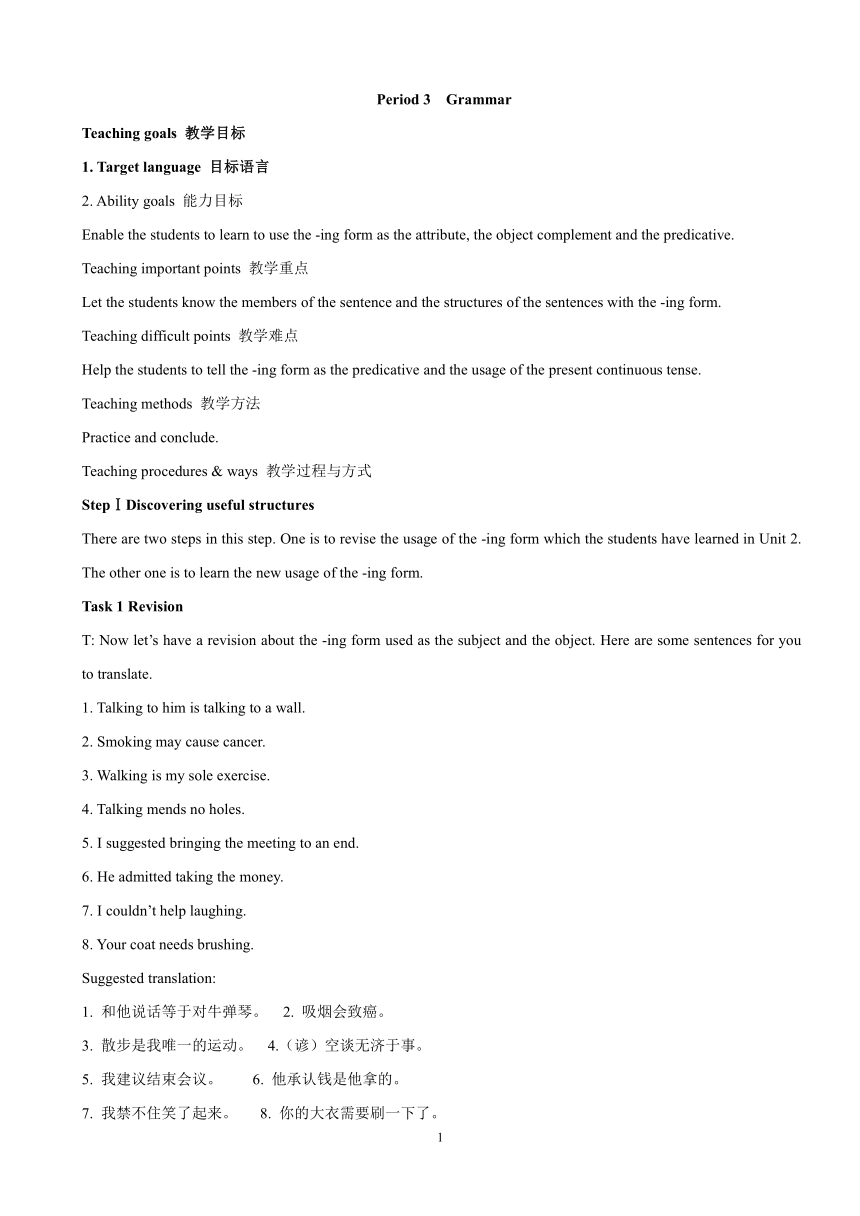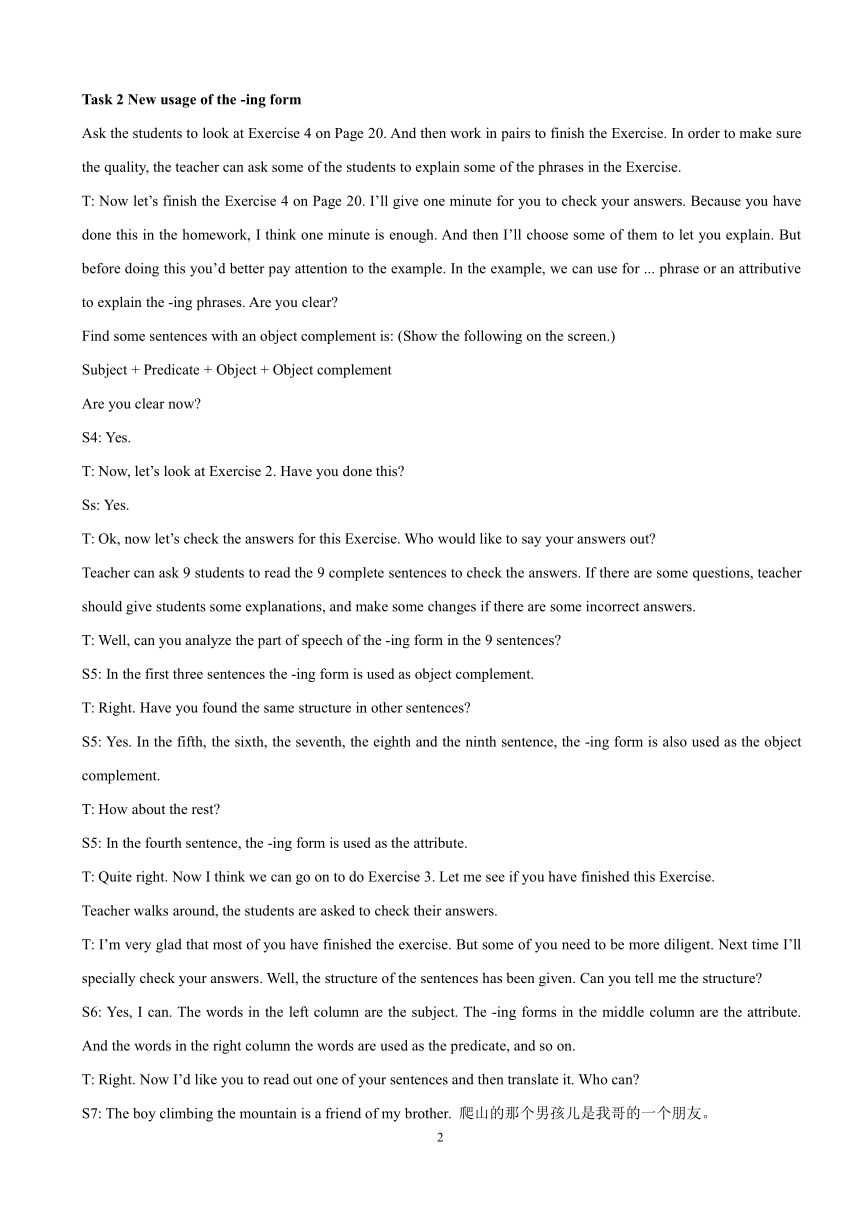人教版高中英语必修四Unit 3 A taste of English humour Period 3 Grammar 教案
文档属性
| 名称 | 人教版高中英语必修四Unit 3 A taste of English humour Period 3 Grammar 教案 |  | |
| 格式 | zip | ||
| 文件大小 | 38.6KB | ||
| 资源类型 | 教案 | ||
| 版本资源 | 人教版(新课程标准) | ||
| 科目 | 英语 | ||
| 更新时间 | 2020-01-26 21:12:30 | ||
图片预览


文档简介
Period 3 Grammar
Teaching goals 教学目标
1. Target language 目标语言
2. Ability goals 能力目标
Enable the students to learn to use the -ing form as the attribute, the object complement and the predicative.
Teaching important points 教学重点
Let the students know the members of the sentence and the structures of the sentences with the -ing form.
Teaching difficult points 教学难点
Help the students to tell the -ing form as the predicative and the usage of the present continuous tense.
Teaching methods 教学方法
Practice and conclude.
Teaching procedures & ways 教学过程与方式
StepⅠDiscovering useful structures
There are two steps in this step. One is to revise the usage of the -ing form which the students have learned in Unit 2. The other one is to learn the new usage of the -ing form.
Task 1 Revision
T: Now let’s have a revision about the -ing form used as the subject and the object. Here are some sentences for you to translate.
1. Talking to him is talking to a wall.
2. Smoking may cause cancer.
3. Walking is my sole exercise.
4. Talking mends no holes.
5. I suggested bringing the meeting to an end.
6. He admitted taking the money.
7. I couldn’t help laughing.
8. Your coat needs brushing.
Suggested translation:
1. 和他说话等于对牛弹琴。 2. 吸烟会致癌。
3. 散步是我唯一的运动。 4.(谚)空谈无济于事。
5. 我建议结束会议。 6. 他承认钱是他拿的。
7. 我禁不住笑了起来。 8. 你的大衣需要刷一下了。
Task 2 New usage of the -ing form
Ask the students to look at Exercise 4 on Page 20. And then work in pairs to finish the Exercise. In order to make sure the quality, the teacher can ask some of the students to explain some of the phrases in the Exercise.
T: Now let’s finish the Exercise 4 on Page 20. I’ll give one minute for you to check your answers. Because you have done this in the homework, I think one minute is enough. And then I’ll choose some of them to let you explain. But before doing this you’d better pay attention to the example. In the example, we can use for ... phrase or an attributive to explain the -ing phrases. Are you clear?
Find some sentences with an object complement is: (Show the following on the screen.)
Subject + Predicate + Object + Object complement
Are you clear now?
S4: Yes.
T: Now, let’s look at Exercise 2. Have you done this?
Ss: Yes.
T: Ok, now let’s check the answers for this Exercise. Who would like to say your answers out?
Teacher can ask 9 students to read the 9 complete sentences to check the answers. If there are some questions, teacher should give students some explanations, and make some changes if there are some incorrect answers.
T: Well, can you analyze the part of speech of the -ing form in the 9 sentences?
S5: In the first three sentences the -ing form is used as object complement.
T: Right. Have you found the same structure in other sentences?
S5: Yes. In the fifth, the sixth, the seventh, the eighth and the ninth sentence, the -ing form is also used as the object complement.
T: How about the rest?
S5: In the fourth sentence, the -ing form is used as the attribute.
T: Quite right. Now I think we can go on to do Exercise 3. Let me see if you have finished this Exercise.
Teacher walks around, the students are asked to check their answers.
T: I’m very glad that most of you have finished the exercise. But some of you need to be more diligent. Next time I’ll specially check your answers. Well, the structure of the sentences has been given. Can you tell me the structure?
S6: Yes, I can. The words in the left column are the subject. The -ing forms in the middle column are the attribute. And the words in the right column the words are used as the predicate, and so on.
T: Right. Now I’d like you to read out one of your sentences and then translate it. Who can?
S7: The boy climbing the mountain is a friend of my brother. 爬山的那个男孩儿是我哥的一个朋友。
T: Your translation is wrong. Try it again.
S7: 爬山的那个男孩儿是我哥的一个朋友。
T: Wrong again. Try again.
S7: But I think I’m right. If you don’t think so, ask the other students.
T: Good idea. But wait a moment. Who would like to make a sentence and translate it again?
S8: Let me try. The girl eating her dinner is very tired and needs rest.
那个吃饭的女孩子很累,而且需要休息一下。
T: The sentence is right, but the translation is not right. Try again.
S8: Miss Wu, I think I’d better not try. I’m afraid my translation is the same. Please tell us why?
T: Do you really want to know?
Ss: Of course.
T: It’s very easy, you need add 正在before the girl and the boy. That’s Ok.
Ss: But it’s the same meaning!
T: Yes, it has the same meaning. I’m not a fool. You are not fools. But when you go out of this classroom, you will be fools. Can you think 做事的男孩 and 正在做事的男孩 has the same meaning? The first one doesn’t give us a clear meaning whether he has done, or is doing, or will to do the thing. While the second one tells us the exact meaning of the -ing form. That is the boy doing the thing. The picture appearing before our eyes is that the boy is doing his things. Later we will study the Past Participle and the Infinitive. In order to get clear meaning of the phrases, we’d better have such exercises. Do you understand?
Ss: Yes.
T: Now let’s try again to see whose translation has such mistakes.
The purpose of doing this is to train the students to have exact understanding about the -ing form, because when they study the -ed form, they will be confused about the difference between the -ing form and the -ed form. So at first, teacher should help them to have a correct understanding at the meaning.
T: OK, it seems that all of you have learned the way to translate the sentences correctly. Well, now let’s look at Ex 4. Who would like to do this exercise? You five please.
S1: Seeing is believing.
S2: His job is cleaning the yard.
S3: What he likes is playing basketball.
S4: The news is exciting.
S5: The film is more interesting than any that I’ve ever seen.
T: Very good. All of them are right. In order to make sure that you master the usage of the structure, I’ll give you some more sentences. Now please look at the screen.
1. Her hobby is painting. 她的爱好是绘画。 2. Her favorite sport is skiing. 她最喜爱的运动是滑冰。 3. This was very disappointing. 这很令人失望。 4. The test results have been very discouraging. 测试的结果很让人沮丧。 5. She was very pleasing in her appearance. 她的外貌很招人喜欢。 6. His concern for his mother is most touching. 他对母亲的关爱很感人。 7. The photograph is missing. 那张照片不见了。 8. The article was misleading, and the newspaper has apologized. 这篇文章有误导性,报纸已经道歉了。
T: In the first two sentences, the -ing form is used to show the character of the subject. In the next four sentences the words of the -ing form are all about the feelings. In the last two sentences, the words of the -ing form show some states and qualities. Now please look at these sentences on the screen.
How are things going? 现在情况怎么样? It’s snowing hard. 天正下着大雪。 What are they quarrelling about? 他们在为什么事争吵? Why aren’t you wearing a coat? It’s so cold. 天这么冷,你怎么没穿大衣? I’m waiting to have a word with you. 我在等着和你说话。 She’s teaching in a night school. 她在夜校教书。Sorry, you can’t take the typewriter away, I’m using it. 对不起,你不能把打字机拿走,我在用。
T: Do you think these -ing forms are also used as the predicative?
S6: No, these -ing forms are used as the predicate in the present continuous tense.
T: That’s quite right. Now do you know how to tell the -ing form as the predicative from what used as predicate in the present continuous tense?
S7: Yes. The -ing form as the predicative shows the quality, or the state of the subject; while the -ing form in the present continuous tense show an act is going.
T: This is a good conclusion. Now let’s turn to the next step.
Step II Homework
T: Today, we learned some useful structures. What are they?
Ss: The -ing form as the attribute, the object complement, and predicative.
T: Good. What should we pay attention in understanding these -ing forms?
Ss: The meanings, the translations, the sentence structures and also the difference between the -ing form as the predicative and those used in the present continuous tense.
T: Right. Now, your homework: finish all Exercises on Page 56. Exercise 1&2 in USING WORDS AND EXPRESSIONS give us a good chance to review what we have learned in this unit.
同课章节目录
